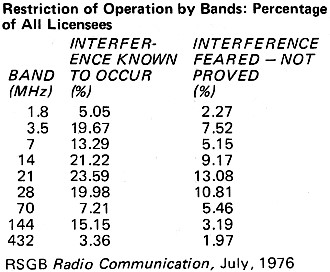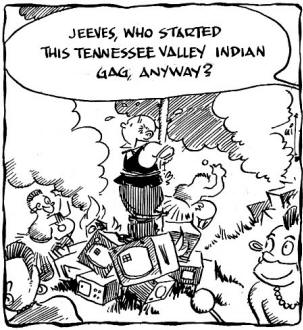|
November 1976 QST
 Table of Contents Table of Contents
Wax nostalgic about and learn from the history of early electronics. See articles
from
QST, published December 1915 - present (visit ARRL
for info). All copyrights hereby acknowledged.
|
When I began reading this piece I
wasn't sure whether it was reporting on interference caused to amateur radio
operation or interference caused by amateur radio operation. It turns out to be
the latter. Ever since radio operation began in the days of Marconi,
unintentional interference has been a problem. The problem has always been a
combination of improper transmitter and/or receiver filtering. Electromagnetic
spectrum regulatory agencies attempt to assess and address interference through
operational band assignments for particular segments of the spectrum, including
how much residual (unintentional) power can be emitted outside of band or within
a defined power mask. Amateur radio operators are often the first group to be
suspected of causing interference, no doubt due to the "amateur" part of their
moniker. In truth, many amateurs are some of the most knowledgeable and
responsible users of the airwaves, and often go to extremes to prevent and
resolve interference issues even when they are not at fault. This 1976 QST
article presents the findings of a survey taken of its members by the
Radio Society of Great Britain (RSGB). In brief,
it found most interference blamed on Ham operators was the result of other types
of RF equipment (TV, AM/FM radio, CB radio, etc.) not incorporating sufficient
filtering to reject signal power legally allowed by amateur transmitters.
Government statistics on reported interference cases abound, but
no one's asked the amateurs what they think until now.
By Theodore J. Cohen, W4UMF
Interference to television sets, stereos, broadcast receivers and other home-entertainment
devices has been a bugaboo of amateur radio since commercial TVs first achieved
popularity in the early 50s. In the United States, with the recent increase in the
popularity of CB radio and a commensurate increase in the number of privately owned
transmitters, the FCC is now receiving interference complaints at a rate of over
100,000 a year. Of the complaints of interference to home-entertainment devices,
only seven percent involve amateur radio operators. Further analysis shows that
of these complaints, almost 90 percent would not have occurred at all if the manufacturers
of the home-entertainment devices had provided adequate filtering or shielding in
their products.

Table 1 - Restriction of Operation by Bands: Percentage of All
Licensees
RSGB Radio Communication, July, 1976
These
statistics suffer a severe limitation in that they record only reported cases of
interference. Many cases of interference go unreported; furthermore, it is entirely
possible that some amateurs restrict their operation for fear of causing interference,
or because they have had some incidents of interference brought to their attention
and prefer not to "rock the boat." It's clear that even though amateurs are involved
in only a small percentage of all reported interference cases, the overall effect
on amateur radio operation is unknown. To get the amateur's point of view, the Radio
Society of Great Britain surveyed its members in May, 1975, to determine the extent
to which British amateur stations are responsible for interference to home-entertainment
equipment. Further, the survey sought to determine the amateur's attitude toward
interference problems and the effect these problems had on operating habits.
A total of 1221 survey forms was returned, about a 10-percent return rate. Since
about 60 percent of the amateurs in Great Britain are RSGB members, the returns
represent about six percent of all licensees in Britain. The results of the survey,
released in July, 1976, provide some interesting statistics on the various types
of interference encountered by UK amateurs. With respect to television interference
(TVI) , for example, the RSGB found that each amateur had 2.65 cases on the average.
Only 17 percent of those surveyed had no TVI complaints. When TVI did occur,
only nine percent of the cases could be cured by modifications made to the amateur
stations involved. Thus, just as in the United States, almost 90 percent of all
TVI cases encountered in the UK must be cured at the television receiver. Of the
cases sampled, 52 per-cent were cured by installing a high-pass filter at the television
receiver's antenna terminals, and so, we conclude that one has about a 50-50 chance
of curing a case of alleged TVI by external modifications alone.
Turning to broadcast interference, each UK amateur, on the average, had about
one case. Almost 56 percent of those surveyed, however, had no BCI at all. When
BCI was encountered, those whose radios were affected expressed little concern,
and as such, a significantly lower percentage of BCT cases were resolved than were
TVI cases.
 With respect to audio frequency interference (AFI), amateurs in the UK have,
on the average, about one case per amateur installation, though 33 percent of those
responding to the survey had no AFI. Where it was encountered, only four percent
of the cases were cured by modifications to the amateur station; more specifically,
such modifications involved repositioning of the amateur's antenna so as to reduce
the local field strength at the audio device. After all, there is nothing an amateur
can do to his or her transmitter which will prevent an audio device from intercepting
and rectifying an RF signal. With respect to audio frequency interference (AFI), amateurs in the UK have,
on the average, about one case per amateur installation, though 33 percent of those
responding to the survey had no AFI. Where it was encountered, only four percent
of the cases were cured by modifications to the amateur station; more specifically,
such modifications involved repositioning of the amateur's antenna so as to reduce
the local field strength at the audio device. After all, there is nothing an amateur
can do to his or her transmitter which will prevent an audio device from intercepting
and rectifying an RF signal.
In expressing their concern for interference problems, roughly 10 percent of
the amateurs responding to the survey said that they were "severely worried," while
26 percent said that they were "moderately worried." An additional 35 percent were
"slightly worried." From these figures we estimate that over one-third of the licensed
amateurs in Great Britain are sufficiently worried about interference problems such
that these problems could influence their operating habits. There is no question,
for example, that concern about interference problems could act to lessen band occupancy,
especially during the evening hours and on weekends, when neighbors are most apt
to be using television receivers and other home-entertainment devices.
The RSGB study concluded that the incidence of interference, especially TVI,
is considerable. Further, the British government underestimates the number of interference
cases which are related to amateur activities because amateurs often resolve these
cases themselves. Finally, it was clearly evident that design deficiencies in home-entertainment
devices are to blame for the majority of interference cases encountered. Thus, only
the manufacturers of such equipment can reduce the number of interference cases
which occur each year and they can do this by designing their products to operate
in the presence of RF fields from nearby transmitters.
We gratefully acknowledge the help of Roy F. Stevens, G2BVN, who provided copies
of the RSGB interference survey to the ARRL RFI Task Force.
Posted September 9, 2020
|











